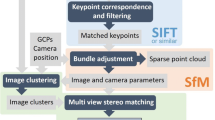Abstract
Human activities such as coal mining may cause rapid ground subsidence, which will damage severely on human-built structures such as coal transport railway or buildings, and even kill lives. In coal-mining areas, ground subsidence happens continuously, and its amplitude may be up to 10 cm per day. In order to assure the safety of coal-mining areas, it’s necessary to monitor the ground subsidence timely and precisely. This paper presents a continuously operating real-time global navigation satellite system ground subsidence monitoring system, which consists of hardware, data processing algorithms and software, communication link and peripheral equipment. A particular architecture was designed for field operation. For the data processing, the Vondrak filter is proposed to process the monitoring data. We operated the proposed monitoring system on the coal-mining area and verified the performance during the mining period from early July to December 2017. The monitoring results show that the proposed system has an accuracy of 5 mm for ground subsidence monitoring on the basis of precise leveling data that were simultaneously observed. The proposed method can meet the accuracy requirement of ground subsidence monitoring, and it can provide continuous subsidence information in real time, which cannot be achieved by the traditional leveling surveying method. The monitoring system and data processing method can be applied to the monitoring of ground subsidence in subsidence area as well as geological disasters such as landslides.








Similar content being viewed by others
References
Abdikan S, Arıkan M, Sanli FB, Cakir Z (2014) Monitoring of coal mining subsidence in peri-urban area of Zonguldak city (NW Turkey) with persistent scatterer interferometry using ALOS-PALSAR. Environ Earth Sci 71:4081–4089
Akcin H, Kutoglu HS, Kemaldere H, Deguchi T, Koksal E (2010) Monitoring subsidence effects in the urban area of Zonguldak Hardcoal Basin of Turkey by InSAR-GIS integration. Nat Hazards Earth Syst Sci 10(9):1807–1814
Baek J, Kim S-W, Park HJ, Jung HS, Kim KD, Kim JW (2008) Analysis of ground subsidence in coal mining area using SAR interferometry. Geosci J 12(3):277–284
Berardino P, Fornaro G, Lanari R, Sansosti E (2002) A new algorithm for surface deformation monitoring based on small baseline differential SAR interferograms. IEEE Trans Geosci Remote Sens 40(11):2375–2383
Demoulin A, Campbell J, De Wulf A (2005) GPS monitoring of vertical ground motion in northern Ardenne-Eifel: five campaigns (1999–2003) of the HARD project. Int J Earth Sci 94(4):515–524
Ferretti A, Prati C, Rocca F (2001) Permanent scatteres in SAR interferometry. IEEE Trans Geosci Remote Sens 39:8–20
Filin S, Baruch A (2010) Detection of sinkhole hazards using airborne laser scanning data. Photogramm Eng Remote Sens 76:577–587
Filin S, Baruch A, Avni Y, Marco S (2011) Sinkhole characterization in the Dead Sea area using airborne laser scanning. Nat Hazards 58:1135–1154
Filin S, Avni Y, Baruch A, Morik S, Arav R, Marco S (2014) Characterization of land degradation along the receding Dead Sea coastal zone using airborne laser scanning. Geomorphology 206:403–420
Ge L, Chang H-C, Rizos C (2007) Mine subsidence monitoring using multi-source satellite SAR images. Photogramm Eng Remote Sens 73(3):259–266
Grewal MS, Andrews AP (2001). Kalman filtering: theory and practice using Matlab. Wiley, New York, pp 14–17, pp 147–148
Hooper A, Zebker H, Segall P, Kampes B (2004) A new method for measuring deformation on volcanoes and other natural terrains using InSAR persistent scatterers. Geophys Res Lett 31:23611. https://doi.org/10.1029/2004gl021737
Ince CD, Sahin M (2000) Real-time deformation monitoring with GPS and Kalman filter. Earth Planets Space 52(10):837–840
Jung HC, Kim S-W, Jung HS, Min KD, Won JS (2007) Satellite observation of coal mining subsidence by persistent scatterer analysis. Eng Geol 92(1):1–13
Kampes BM (2006) Radar interferometry-persistent scatterer technique. Kluwer, Dordrecht
Li L, Peng J (2014) Multiple Kalman filters model with shaping filter GPS real-time deformation analysis. Trans Nonferrous Met Soc China 24:3674–3681
Mora O, Mallorqu JJ, Broquetas A (2003) Linear and nonlinear terrain deformation maps from a reduced set of interferometric SAR images. IEEE Trans Geosci Remote Sens 41:2243–2253
Ng AHM, Chang H-C, Ge L, Rizos C, Omura M (2009) Assessment of radar interferometry performance for ground subsidence monitoring due to underground mining. Earth Planet Space 61(6):733–745
Prati C, Ferretti A, Perissin D (2010) Recent advances on surface ground deformation measurement by means of repeated space-borne SAR observations. J Geodyn 49:161–170
Tao L, Zhang H, Wang C, Tangn YX (2012) Ground deformation retrieval using quasi coherent targets DInSAR, with application to suburban area of Tianjin, China. IEEE J Sel Top Appl Remote Sens 5(3):867–873
Vondrak J (1977) Problem of smoothing data. Bull Astron Inst Czechoslov 28(2):84–89
Wang J, Peng X, Xu C (2011) Coal mining GPS subsidence monitoring technology and its application. Min Sci Technol (China) 21:463–467
Yang Y, He H, Xu G (2001) Adaptively robust filtering for kinetic geodetic positioning. J Geodesy 2001(75):109–116
Zhang Z, Wang C, Tang Y, Fu O, Zhang H (2015a) Subsidence monitoring in coal area using time-series InSAR combining persistent scatterers and distributed scatterers. Int J Appl Earth Obs Geoinf 39:49–55
Zhang Z, Wang C, Tang Y, Fu Q, Zhang H (2015b) Subsidence monitoring in coal area using time-series InSAR combining persistent scatterers and distributed scatterers. Int J Appl Earth Obs Geoinf 2015(39):49–55
Zhao CH, Zhang Q, Wang L (2004) The application research of GPS height difference in landslip monitoring. Bull Surv Mapp 33(4):303–306
Zheng D, Zhong P, Ding X, Chen W (2005) Filtering GPS time series using a Vondrak filter and cross-validtaion. J Geod 79(6–7):363–369
Acknowledgements
This work was supported Open Research Fund (16P02) of State Key Laboratory of Information Engineering of Surveying, Mapping and Remote Sensing and Natural Science Foundation of Anhui Province, China (1808085MD105).
Author information
Authors and Affiliations
Corresponding author
Rights and permissions
About this article
Cite this article
Tao, T., Liu, J., Qu, X. et al. Real-time monitoring rapid ground subsidence using GNSS and Vondrak filter. Acta Geophys. 67, 133–140 (2019). https://doi.org/10.1007/s11600-018-0230-2
Received:
Accepted:
Published:
Issue Date:
DOI: https://doi.org/10.1007/s11600-018-0230-2




